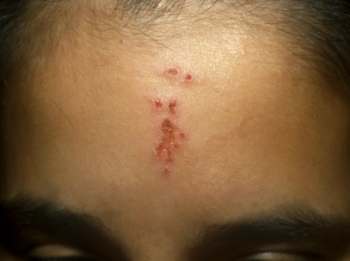
- Consultant for Pediatricians Vol 23 No 5
- Volume 23
- Issue 5
Photo Essay: The Butterfly Technique: A New Method of Inserting an Umbilical Vessel Catheter
Photo Essay: The Butterfly Technique: A New Method of Inserting an Umbilical Vessel Catheter
The conventional method of placing an umbilical artery catheter in neonates involves cutting the cord approximately 1 cm above the skin/cord junction. The cord stump is then held steady with 2 or more hemostats while the vessels are dilated and cannulated.1-3 Although this method has been successfully employed by generations of pediatricians, the technique requires considerable practice to master.
Most cases of unsuccessful catheter insertion result from awkward positioning and handling of the umbilical stump, which tends to retract into the abdomen. It is nearly impossible to get a firm grasp, which makes it difficult to visualize umbilical vessels. This results in the creation of false tracts during vessel dilation and/or perforation of the vessel when attempts are made to insert the catheter.
We have experimented with several small modifications of standard catheter insertion techniques that can make it easier to insert an umbilical artery line. Our technique facilitates successful line placement.
A BUTTERFLY TECHIQUE
Professional cooks use the term "butterfly" to describe the partial cutting of a fillet or other food item in a manner that increases the surface area exposed to heat.We advocate a butterfly technique in which the umbilical cord is partially sliced so that the umbilical artery is exposed. When the upper flap of the cord is folded over, the umbilical vessels are pulled upward and outward. They are easily identified and are fixed in place by the tension placed on the folded cord flap.
Mechanical advantage is maximized because:
The cord stump is the fulcrum.
The hemostat is the lever.
The directionality of catheter insertion is the inclined plane.
Practitioners at all levels of experience have had success with this technique.
References:
REFERENCES:
1.
MacDonald MG. Umbilical artery catheter insertion. In: Cunningham MD, Eyal FG, Zenk KE, eds.
Neonatology: Management, Procedures, On-Call Problems, Diseases, and Drugs.
5th ed. New York: McGraw-Hill; 1999:160-164.
2.
Shilkofski N. Procedures. In: Robertson J, Shilkofski N, eds.
The Harriet Lane Handbook.
17th ed. St Louis: Mosby Inc; 2005:73-104.
3.
MacDonald MG. Umbilical artery catheterization. In: MacDonald MG, Ramasethu J, eds.
Atlas of Procedures in Neonatology.
3rd ed. Philadelphia: Lippincott Williams & Wilkins; 2002:152-170.
Articles in this issue
almost 20 years ago
Musculoskeletal Clinics: 12-Year-Old With Knee Pain From Kickball Injuryalmost 20 years ago
Pediatric Urology Clinics: Red Urine in an 8-Year-Old Boyalmost 20 years ago
Photoclinic: Swallowed Beadsalmost 20 years ago
Infected Cystic Hygromaalmost 20 years ago
Necrobiosis Lipoidica in an Adolescentalmost 20 years ago
Case In Point: Infantile Hypertrophic Pyloric Stenosisalmost 20 years ago
Psoriasis in an 11-Month-Old Infantalmost 20 years ago
Halo Nevus and Nevus Spilusalmost 20 years ago
Photoclinic: Imperforate Anus With Anocutaneous FistulaNewsletter
Access practical, evidence-based guidance to support better care for our youngest patients. Join our email list for the latest clinical updates.









